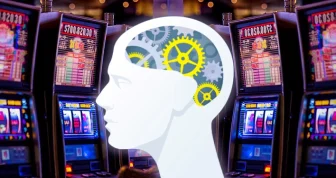
Since the conception of the casino industry as a whole, there have been speculations about how gambling houses implement a variety of subtle (and sometimes not so subtle) elements that are meant to affect their customers in a way that will be more profitable to the establishment. Have you noticed why they offer free alcoholic beverages and other compliments to nearly all players? Do you find it strange that the decor of nearly all casinos worldwide looks practically the same? We are taking a deep dive in the psychology behind casino design, which will hopefully help you understand how the house is trying to play you!

Have you seen windows or any type of transparent panes, or doors in a casino? Exactly, there are none! Some people might think that this is a tactic that is employed by the casino’s management in order to prevent onlookers from the outside to take a peek at what’s going on inside, but that is a superficial reason. The truth behind it is actually “time”. When a player walks into a gambling establishment, the casino wants them to walk into an environment where time seems to be frozen.
Naturally, daylight is a pretty good indicator that you might be spending too much time within the casino, which is why all doors and windows are either plastered with heavy-duty vinyl or absent altogether. If you don’t have a watch on you and you would like to find out what is the time, don’t look at a wall in a casino – just for the same reason daylight is prevented from hitting the casino grounds, wall clocks are missing too.
From the moment you step on a casino floor, your actions within the casino are pre-determined. This is thanks to the work of one man – Bill Friedman. A former compulsive gambler, Mr Friedman developed a set of design principles for casinos that would effectively make every customer spend more time within a gambling house and spend more money. The removal of perception of time described above is part of one of these principles, but it is just a small cog in a very large wheel. With that being said, here are the disambiguation of thirteen design principles that Mr Friedman came up with that are used by casinos even today:
While most of these rules are pretty self-explanatory, some could use additional definitions. For example, those rules that depict how a casino should look overcrowded with gaming machines, are meant to implement sensory confusion in the player while exerting an amount of psychological pressure. This will make the visitor then stop at the nearest possible gaming machine and spend some money. This is the same reason why there are no signs pointing out at the casino exit or the lavatory.

As an exact opposite to the principles created by Friedman, Robert Thomas was the one to develop principles of his own when it comes to the design of a gambling house. When it came to the overall experience, Robert Thomas proposed a full “open concept” of the entire casino environment. The theory behind his design solutions was based on the assumption that players who instantly felt comfortable in large open spaces that looked as luxurious as possible, would spend a lot more money. And it worked!
Casinos that were developed with the Thomas design principles featured high ceilings, large open floors, impeccably organised gaming sections, and clearly defined pathways that allowed players to feel more “free”. Just like the principles of Friedman, however, there are also a few drawbacks to this type of casino floor. Although the Adult Playground design seems to be preferred by most people, the truth is that it isn’t as cost-effective as the one that is implemented by Friedman.
After all, creating large open spaces means that there will be a lot of floor real estate that won’t be populated by gaming machines, hence reducing the casino’s profitability. On the other hand, this is somewhat evened out, as Adult Playground casinos feature high-value action, which is why the majority of the visitors there are known to have “deeper pockets”.
Both the casino design principles of Friedman and Thomas are a part of a larger social experience system for predictive behaviour, albeit they are on the opposite ends of its spectrum. With that being said, from the moment a player steps on the casino floor, they will be bombarded with visual and auditory information; however, it is the intensity at which this happens, that can affect a casino’s profitability. With that being said, the most common traits of a casino’s design that are classified as having an “information load” factor, are the lighting, colour treatment, crowding organisation and gaming machine grouping. Here is how they would look like, when we factor in the low and high information load values.
High Sensory Information Load
Low Sensory Information Load
The truth is that although there are some casinos that utilise the sensory information load principles to their lowest or highest values, some of the most successful gambling establishments in the world have tried to achieve a careful balance. In fact, those factors are quite dynamic, and can be adjusted in accordance with the current economic trends of the gambling industry. The bottom line is that whatever the intensity of these factors is, they are still meant to influence the decision making of players who enter the grounds of the casino.

In a study done some years ago, casinos decided to see if the presence of pleasant smells in particular gaming sections would increase attendance by customers. It turns out, that it did! In a test environment where one section of slots was scented and the other one wasn’t, there was more than a 40% increase in attendance and profitability recorded in the gaming section that was scented. What’s even more interesting, is that the studies themselves as well as the results were made public by those very same casinos – after all, installing air fresheners in any commercial environment is not against the law.
Pure Oxygen is known to increase the efficiency of the red blood cells in the human body. What this means, is that a person that breathes concentrated Oxygen will feel more confident, more alert, and energetic! The motive behind that is even if the player loses their money, they will still feel somewhat good about it, because the casino gameplay environment has been saturated with Oxygen. However, the use of Oxygen in casinos is a popular myth that is not officially confirmed.

It’s only natural that sometimes spilt drinks or other items can find themselves on the ground. Casinos have an exceptionally active maid staff that will take care of any such accidents in a manner of minutes. If the area has been affected by a foul smell, it will be re-scented.
Do you like those free drinks you’ve been receiving for the last hour? The casino will keep them coming for you in hopes that you will make yourself intoxicated and spend a little bit more money. In fact, casinos have the habit of giving their most consistent players comps such as dinner vouchers, tickets to events, and even hotel rooms.
The player might think that they “got something out of it”, but in fact, they have already paid for it many times over by playing in the casino and losing money.
Interestingly enough, not so much! Perhaps, the only thing that can be somewhat described as a way to entice players to play more, are vivid colours, bright lettering, and bonus ads – all of which is perfectly acceptable. We should mention however, that less-than-reputable online gambling websites incorporate particular design choices when it comes to the way the most important looks of the casino’s website. Some of those non-honourable tactics include:
Even if an online casino is reputable, they will still try to emulate as much as they can from their land-based cousins, while leaning heavily on the sensory information overload factors. This is why in the majority of the UK casino sites, the first thing you see when you open it is a clump of hundreds of online casino games and promotions. Although not as efficient as it is in a physical casino environment, it still works.
While it does sound a bit sinister, this is the reality of the gambling industry. The fact is that these “tempting tactics” are considered to be a form of advertisement, which doesn’t force anyone to do something against their will. Whether you’re influenced or not, will be a testament to your own willpower. Although the whole “psychology behind casino design” seems to be quite sinister, it might be considered a bit shady if it was hidden from the public. Instead, the casinos make sure that everyone who is interested in the industry know about this, and still be capable of making their own choice.
When it comes to the morality aspect of “design psychology”, this is something that is individually answered by every person. After all, some people would say that the casino design tactics verge on borderline manipulation, but the truth is that a good portion of those very same rules and principles are also implemented in department stores, restaurants, and many other commercial establishments. Whether you’re a gambler or a buyer, beware!